
The “National Rangeland Health Assessment Report”, presented to the Mongolian government at a workshop held on May 28, summarises the results of a six-year research project carried out by the National Agency of Meteorology and Environmental Monitoring, the National University of Life Sciences, the Academy of Sciences, the Agency of Land Affairs, the Geodesy and Cadastre and SDC’s Green Gold Project.
“Addressing rangeland health is an important issue given that it is the backbone of one of Mongolia’s strategic sectors and will ensure national food security and employment creation in rural areas,” said Minister of Food and Agriculture R. Burmaa in her opening address at the workshop.
According to the report, the primary challenge to sustainable livestock production in Mongolia is the decline in rangeland health in many parts of the country.
Causes and Solutions
The trends of significant climatic warming, declining levels of precipitation and increasing livestock numbers pose a risk of further rangeland degradation, particularly in the central and northern parts of Mongolia.
The report suggests that grazing management practices associated with healthy pastures should be maintained in some areas, whereas in other areas management practices should be altered to promote perennial grass recovery, a reduction in the dominance of degradation indicator plants, and control soil erosion.
A new, comprehensive approach focused on the sustainable production of meat, fibre and other environmental goods and services was required. However, livestock numbers in excess of pasture carrying capacity remains the primary barrier to sustainable livestock production.
According to the report, increases in livestock numbers are likely to intensify and further exacerbate rangeland degradation. However, there were ample opportunities for changes in management practice and policy that improved rangeland health, that enabled adaptation to climate and land-use change in the long term, and that secured the future of pastoral production and food security in Mongolia. However, it was vital to act decisively and promptly before those opportunities were lost.
According to the report: “A vast majority of monitoring sites, representing more than half of Mongolia’s rangelands, suggest that changes to grazing management could result in recovery or progress toward recovery within 10 years.”
Download the full report (PDF, 66 Pages, 2.2 MB) in English
To find more about the project, please visist:

